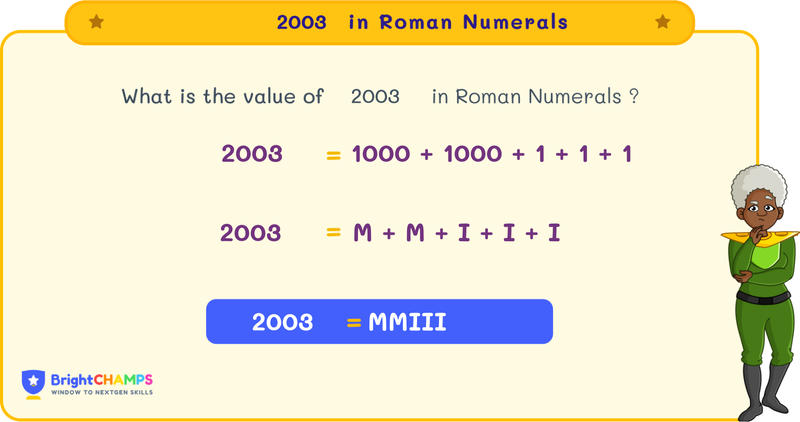
 177 Learners
177 LearnersLast updated on May 26th, 2025

2003 in Roman Numerals

Roman numerals are a way of expressing numbers using symbols. I, V, X, L, C, D, and M are the symbols we use. Roman Numerals are used in royal titles, book names, sequences, and so on. Here we will be discussing Roman Numerals, rules, and examples.
What is 2003 in Roman Numerals?
The royal titles, such as Henry I, Henry II, and so on. Have you noticed the names and wondered what these symbols (I and II) represented?
Those are the Roman Numerals. Earlier people used to count using fingers, sticks, bones, etc., to count earlier. When life became complex, a standard form was required to count. Ancient Romans used the Roman Numeral system to count. I (1), V (5), X (10), L (50), C (100), D (500), and M (1000) are the symbols we use to count.
In Roman Numerals, we use MMIII to represent 2003. Here, MM is 2000, and III is 3. Let’s learn more about Roman numerals and how we write them.
Struggling with Math?
Get 1:1 Coaching to Boost Grades Fast !

Basic Rules for 2003 in Roman Numerals
There are certain basic rules for writing a number in Roman Numerals. In this section, let’s discuss some basic rules that need to be remembered when writing a number in Roman numerals.
Rule 1: Addition Method
The addition method is used when the smaller number is placed after the larger number. For example, VIII → V + III → 5 + 3 = 8
Rule 2: Repetition Method
To write a large number, there are certain Roman Numerals that can be repeated three times. III → 3.
Rule 3: Subtraction Method
If a small number is followed by a large number in Roman Numerals, we subtract the smaller number from the large number. For example, IX → X - I → 10 - 1 = 9
Rule 4: Limitation Rule
The symbols cannot be repeated more than three times, and some symbols like V, L, and D cannot be repeated. For example, we won't write VV for 10; instead, we use X, and for 8, we write VIII, not IIIIIIII.
How to Write 2003 in Roman Numerals
Let’s now learn how to write 2003 in Roman Numerals. Follow these methods to write the number in Roman Numerals.
- By Expansion Method
- By Grouping Method
2003 in Roman Numerals by Expansion Method
In the expansion method, based on the place value, the number is broken down. In this section, we will learn how to write 2003 in Roman numerals using the expansion method.
To write 2003 in Roman Numerals, follow the steps:
Step 1: Break the number based on the place value. Place values are ones, tens, hundreds, etc. For 2003, we write it as 2000 + 3.
Step 2: Convert the number into Roman Numerals.
2000 in Roman Numerals — MM
3 in Roman Numerals — III
Step 3: Combine the Roman Numerals together.
Therefore, 2003 in Roman Numerals is MM (2000) + III (3) = MMIII.
2003 in Roman Numerals by Grouping Method
When writing a large number in Roman Numerals, we group the number.
To write 2003 in Roman Numerals, we group 2003 as 2000 + 3.
2000 in Roman Numerals — MM
3 in Roman Numerals — III
So, 2003 is written as MMIII in Roman Numerals.

Common Mistakes and How to Avoid Them in 2003 Roman Numerals
Students make mistakes when writing a number in Roman Numerals. To master Roman Numerals, we can learn a few common mistakes and the ways to avoid them.
Level Up with a Math Certification!
2X Faster Learning (Grades 1-12)


2003 in Roman Numerals Examples

Problem 1
A historian finds a manuscript dated MMIII. How many years ago was that from the year 2023?

The manuscript is 20 years old.
Explanation
The manuscript date MMIII represents the year 2003 in Roman numerals.
To find how many years ago that was from 2023, subtract 2003 from 2023:
2023 - 2003 = 20.
So, the manuscript is 20 years old.

Problem 2
An ancient inscription mentions the founding of a city in the year MMIII. If the city celebrates its centennial, what year will it be?

The city will celebrate its centennial in the year 2103.
Explanation
The city was founded in the year MMIII, which is 2003.
A centennial is 100 years later. 2003 + 100 = 2103.
Therefore, the city will celebrate its centennial in the year 2103.

Problem 3
Convert the result of multiplying MMIII by II into Roman numerals.

The result of multiplying MMIII by II in Roman numerals is MMMVI.
Explanation
MMIII represents the year 2003. II represents the number 2.
Multiplying 2003 by 2 gives us 4006.
4006 in Roman numerals is MMMVI.

Problem 4
A time capsule buried in MMIII is to be opened after XX years. In what year will it be opened?

The time capsule will be opened in the year 2023.
Explanation
The time capsule was buried in the year MMIII, which is 2003. XX represents the number 20.
Adding 20 years to 2003 gives us 2023.
Therefore, the capsule will be opened in 2023.

Problem 5
If a collector has MMIII coins and gains an additional D, how many coins does he have in total, and what is this number in Roman numerals?

The collector has a total of MMMDIII coins.
Explanation
The collector originally has MMIII coins, which is 2003. He gains an additional D coins, where D is 500.
The total number of coins is 2003 + 500 = 2503.
2503 in Roman numerals is MMMDIII.

Turn your child into a math star!
#1 Math Hack Schools Won't Teach!


FAQs on 2003 in Roman Numerals
1.What is 9 in Roman numerals?
2.How to write 2003 in Roman numerals?
3.What is 16 in Roman Numerals?
4.Is MMIII a prime number?
5.What are the multiples of 2003?
6.How can children in Qatar use numbers in everyday life to understand 2003 in Roman Numerals?
7.What are some fun ways kids in Qatar can practice 2003 in Roman Numerals with numbers?
8.What role do numbers and 2003 in Roman Numerals play in helping children in Qatar develop problem-solving skills?
9.How can families in Qatar create number-rich environments to improve 2003 in Roman Numerals skills?
Struggling with Math?
Get 1:1 Coaching to Boost Grades Fast !

Important Glossaries for 2003 in Roman Numerals
- Addition rule: The addition method is used when a large number is followed by a smaller numeral; here, the values are added. For example, MMIII = MM + III = 2000 + 3 = 2003.
- Grouping method: Here the given numbers are grouped based on their place value, and then we convert each group into its Roman numerals. For example, 2003 = 2000 + 3 = MMIII.
- Repetition rule: Certain symbols (I, X, C, M) in the Roman numeric system can be repeated only up to three times. For example, III = 3 (I is repeated three times to represent the number 3).
- Subtraction rule: The subtraction method is used when a smaller numeral precedes a larger numeral. For example, IX = X - I = 10 - 1 = 9.
- Place Value: Understanding the place value helps in breaking down numbers for conversion. For example, 2003 = 2000 (thousands) + 3 (ones).
Explore More numbers
![Important Math Links Icon]() Previous to 2003 in Roman Numerals
Previous to 2003 in Roman Numerals
About BrightChamps in Qatar


Hiralee Lalitkumar Makwana
About the Author
Hiralee Lalitkumar Makwana has almost two years of teaching experience. She is a number ninja as she loves numbers. Her interest in numbers can be seen in the way she cracks math puzzles and hidden patterns.
Fun Fact
: She loves to read number jokes and games.




